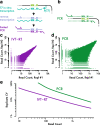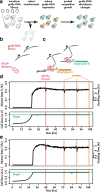A genome-scale CRISPR interference guide library enables comprehensive phenotypic profiling in yeast
- PMID: 33757429
- PMCID: PMC7986282
- DOI: 10.1186/s12864-021-07518-0
A genome-scale CRISPR interference guide library enables comprehensive phenotypic profiling in yeast
Abstract
Background: CRISPR/Cas9-mediated transcriptional interference (CRISPRi) enables programmable gene knock-down, yielding loss-of-function phenotypes for nearly any gene. Effective, inducible CRISPRi has been demonstrated in budding yeast, and genome-scale guide libraries enable systematic, genome-wide genetic analysis.
Results: We present a comprehensive yeast CRISPRi library, based on empirical design rules, containing 10 distinct guides for most genes. Competitive growth after pooled transformation revealed strong fitness defects for most essential genes, verifying that the library provides comprehensive genome coverage. We used the relative growth defects caused by different guides targeting essential genes to further refine yeast CRISPRi design rules. In order to obtain more accurate and robust guide abundance measurements in pooled screens, we link guides with random nucleotide barcodes and carry out linear amplification by in vitro transcription.
Conclusions: Taken together, we demonstrate a broadly useful platform for comprehensive, high-precision CRISPRi screening in yeast.
Keywords: Budding yeast; CRISPR interference; Pooled screening.
Conflict of interest statement
The authors declare that they have no competing interests.
Figures






Similar articles
-
Quantitative CRISPR interference screens in yeast identify chemical-genetic interactions and new rules for guide RNA design.Genome Biol. 2016 Mar 8;17:45. doi: 10.1186/s13059-016-0900-9. Genome Biol. 2016. PMID: 26956608 Free PMC article.
-
CRISPRi-seq for genome-wide fitness quantification in bacteria.Nat Protoc. 2022 Feb;17(2):252-281. doi: 10.1038/s41596-021-00639-6. Epub 2022 Jan 7. Nat Protoc. 2022. PMID: 34997243 Review.
-
CRISPRi-Driven Genetic Screening for Designing Novel Microbial Phenotypes.Methods Mol Biol. 2024;2760:117-132. doi: 10.1007/978-1-0716-3658-9_7. Methods Mol Biol. 2024. PMID: 38468085
-
Maximizing CRISPRi efficacy and accessibility with dual-sgRNA libraries and optimal effectors.Elife. 2022 Dec 28;11:e81856. doi: 10.7554/eLife.81856. Elife. 2022. PMID: 36576240 Free PMC article.
-
Enhanced scale and scope of genome engineering and regulation using CRISPR/Cas in Saccharomyces cerevisiae.FEMS Yeast Res. 2019 Nov 1;19(7):foz076. doi: 10.1093/femsyr/foz076. FEMS Yeast Res. 2019. PMID: 31665284 Review.
Cited by
-
Plasmid and Sequencing Library Preparation for CRISPRi Barcoded Expression Reporter Sequencing (CiBER-seq) in Saccharomyces cerevisiae.Bio Protoc. 2022 Apr 5;12(7):e4376. doi: 10.21769/BioProtoc.4376. eCollection 2022 Apr 5. Bio Protoc. 2022. PMID: 35530514 Free PMC article.
-
Synthetic evolution of Saccharomyces cerevisiae for biomanufacturing: Approaches and applications.mLife. 2025 Feb 23;4(1):1-16. doi: 10.1002/mlf2.12167. eCollection 2025 Feb. mLife. 2025. PMID: 40026576 Free PMC article. Review.
-
Precise measurement of molecular phenotypes with barcode-based CRISPRi systems.bioRxiv [Preprint]. 2024 Jun 22:2024.06.21.600132. doi: 10.1101/2024.06.21.600132. bioRxiv. 2024. Update in: Genome Biol. 2025 May 25;26(1):142. doi: 10.1186/s13059-025-03610-w. PMID: 38948701 Free PMC article. Updated. Preprint.
-
A joint PCR-based gene-targeting method using electroporation in the pathogenic fungus Trichosporon asahii.AMB Express. 2022 Jul 14;12(1):91. doi: 10.1186/s13568-022-01431-9. AMB Express. 2022. PMID: 35834071 Free PMC article.
-
An inducible CRISPR interference library for genetic interrogation of Saccharomyces cerevisiae biology.Commun Biol. 2020 Nov 27;3(1):723. doi: 10.1038/s42003-020-01452-9. Commun Biol. 2020. PMID: 33247197 Free PMC article.
References
MeSH terms
Substances
Grants and funding
LinkOut - more resources
Full Text Sources
Other Literature Sources
Molecular Biology Databases
Research Materials

